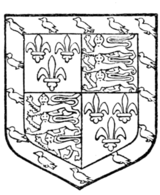issued, and are not hereditary. Of late their use, or perhaps may be their issue, has not been quite so particularly conformed to as is desirable, and at the present time the official records show the arms of their Royal Highnesses the Duchess of Fife, the Princess Victoria, and the Queen of Norway, still bearing the label of five points indicative of their position as grandchildren of the sovereign, which of course they were when the warrants were issued in the lifetime of the late Queen Victoria. In spite of the fact that the warrants have no hereditary limitation, I am only aware of two modern instances in which a warrant has been issued to the son of a cadet of the Royal House who had previously received a warrant. One of these was the late Duke of Cambridge. The warrant was issued to him in his father's lifetime, and to the label previously assigned to his father a second label of three points gules, to be borne directly below the other, was added. The other case was that of his cousin, afterwards Duke of Cumberland and King of Hanover. In his case the second label, also gules, was charged with the white horse of Hanover.

Fig. 730.—John of Gaunt, Duke of Lancaster, bore: France (ancient) and England quarterly, a label of three points ermine (i.e. each point charged with three ermine spots).
The label of the eldest son of the heir-apparent to the English throne is not, as might be imagined, a plain label of five points, but the plain label of three points, the centre point only being charged. The late Duke of Clarence charged the centre point of his label of




